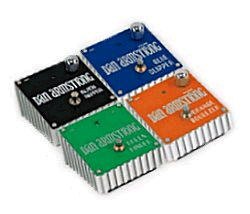

|
While the (then) newly released Dan Armstrong effects units were immediately popular, a great number of requests came in
for these effects to be made in a floor type stompbox version. Ironically and, according to Dan, Musitronics had
promised to do this decades earlier, but being it was more toward the end days of that company, it never came to fruition. After enough
requests, on July 10th 2007 Grafton Electronics released an announcement, stating that they were going to
release the Dan Armstrong effects units in a stomp-box type housing.
|
"Although the original Dan Armstrong effects units could certainly be used live they were really built more for
studio use which is why they have the locking tabs on them - so they could be stacked together in a studio." said
Chuck Wojack, then the owner of Grafton Electronics and who held the licensing to the Dan Armstrong effects when I
interviewed him - and who went on to add "when it came time to produce floor type stomp boxes I wanted to keep the
same look and feel going as the original units. Naturally we kept the same name and I kept with the same colors on the
face plates. Lastly, I wanted to keep the interlocking tabs that were on the original units."
"At the same time I also knew that we had to offer more than just the same effect in a floor version" said
Chuck who continued with "so we added much more. For example, the Orange Squeezer and the
Blue Clipper both had a volume control adjustment located within the original units. It's stated such
on the instructions that accompanied those units back then and it's stated on these reissue units as well. However, when
it came time to build a floor type stomp box, we decided to put those volume controls on the outside in the form of a larger
knob so the player could easily adjust the volume of the effect relative to the original signal."
Chuck added "With players using their foot on these units, we knew that the paint and finish on the faceplate had to
be exceedingly tough. We put an epoxy type paint on the faceplate, then baked it in an oven for one to two hours.
Afterwards we add the silk screening - the Dan Armstrong name and the name of the effect - and we bake it again for
approximately the same amount of time."
"I wanted the outside tabs to do more than just resemble the outward appearence of the original units and so we shape
the tabs in a dove-tail type fashion that satisfies the goal of allowing these units to maintain their original
appearance, but it also allows the floor boxes to slide and actually lock together - thus no pedal board is needed
when using more than one of our floor pedals."
Each unit has a colored light that gets activated when the effect is on, so for example when the Blue Clipper is on
a little blue light, or LED is lit. If the Green Ringer is on a green LED is lit. "The only pedal that does not have
an LED to match the color of the faceplate is the Black Reaper - because the Reaper is in black we just used a white LED." said Chuck.
For chaining more than one unit to another - a shielded 6" patch cord accompanies each and every pedal as does a 9 volt
battery. These units include an external power supply jack which would require a 9 volt 500 milliamp power supply (not
included) and the center tip is positive.
Lastly the circuit board is redesigned just enough to allow for a special silent switching circuit that eliminates
any 'popping' when one activates and deactivates the effects units.
On August 17, 2007 - some 34 years after Dan was promised a stomp styled box for his sound modifiers, Grafton Electronics
had announced that the Dan Armstrong floor styled stomp boxes were shipping.
menu
Names and images are TMand © Dan Armstrong / Ampeg. All rights reserved.
All other names and images are TMand © of their respective owners. All rights reserved.
|
| |

